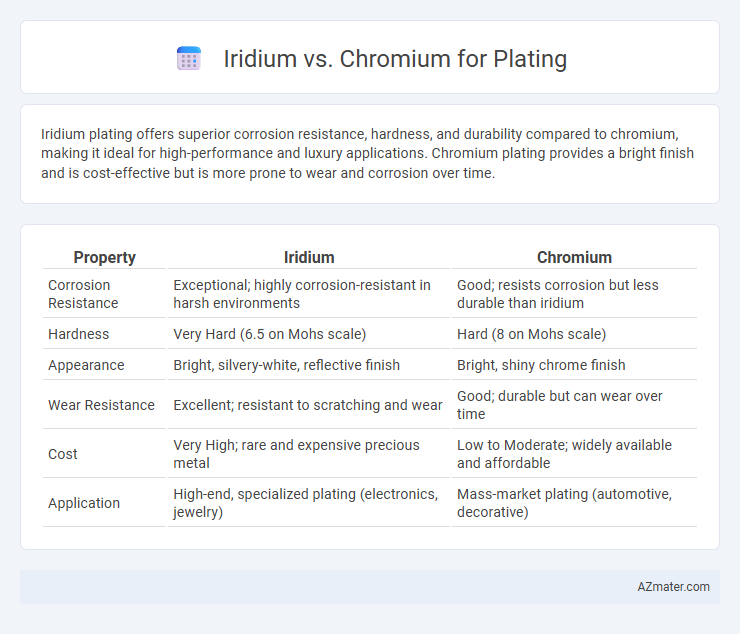Iridium plating offers superior corrosion resistance, hardness, and durability compared to chromium, making it ideal for high-performance and luxury applications. Chromium plating provides a bright finish and is cost-effective but is more prone to wear and corrosion over time.
Table of Comparison
| Property | Iridium | Chromium |
|---|---|---|
| Corrosion Resistance | Exceptional; highly corrosion-resistant in harsh environments | Good; resists corrosion but less durable than iridium |
| Hardness | Very Hard (6.5 on Mohs scale) | Hard (8 on Mohs scale) |
| Appearance | Bright, silvery-white, reflective finish | Bright, shiny chrome finish |
| Wear Resistance | Excellent; resistant to scratching and wear | Good; durable but can wear over time |
| Cost | Very High; rare and expensive precious metal | Low to Moderate; widely available and affordable |
| Application | High-end, specialized plating (electronics, jewelry) | Mass-market plating (automotive, decorative) |
Introduction to Iridium and Chromium Plating
Iridium plating offers exceptional corrosion resistance and hardness, making it ideal for high-wear applications requiring durability and chemical stability. Chromium plating, known for its bright, reflective finish, provides excellent corrosion resistance and aesthetic appeal, commonly used in automotive and decorative industries. Both metals require precise electroplating techniques, with iridium emphasizing superior longevity and chromium prioritizing appearance and moderate protection.
Chemical Properties Comparison
Iridium exhibits exceptional chemical resistance due to its high corrosion and oxidation resistance, maintaining stability even in aggressive acidic environments, while chromium forms a passive oxide layer that protects against corrosion but can degrade under extreme conditions. The atomic number of iridium is 77, with a high melting point of 2446degC, contributing to superior durability in plating applications compared to chromium's atomic number 24 and melting point of 1907degC. Iridium's inert nature ensures minimal reactivity, making it ideal for long-lasting, high-performance coatings, whereas chromium's higher chemical reactivity can result in faster wear and potential toxicity concerns in certain applications.
Hardness and Durability
Iridium plating offers exceptional hardness, reaching around 6.5 on the Mohs scale, making it one of the hardest metals used in plating applications, significantly enhancing wear resistance. Chromium plating, while less hard with a Mohs hardness of approximately 8, provides excellent corrosion resistance and durability in industrial environments. Iridium's superior hardness contributes to greater durability against scratches and deformation, ideal for high-wear components, whereas chromium ensures durable protection for aesthetic and functional surfaces.
Corrosion Resistance
Iridium excels in corrosion resistance due to its exceptional chemical stability and inertness, making it highly effective for plating applications exposed to harsh environments. Chromium offers good corrosion resistance with a durable oxide layer that protects underlying metals, but it can degrade under acidic or high-temperature conditions. While iridium plating ensures superior long-term protection against oxidation and chemical attack, chromium plating provides a more cost-effective corrosion-resistant solution for less demanding applications.
Aesthetic Appearance and Finish
Iridium plating offers a brilliant, highly reflective finish with exceptional corrosion resistance, resulting in a luxurious and durable aesthetic ideal for high-end jewelry and watches. Chromium plating provides a bright, mirror-like appearance that enhances surface hardness and resistance to tarnish, commonly used in automotive and household fixtures for its cost-effectiveness and appealing shine. The choice between iridium and chromium depends on the desired balance between premium luster and budget-friendly durability.
Industrial Applications
Iridium offers exceptional corrosion resistance and hardness, making it ideal for plating in industrial applications requiring extreme durability and chemical resistance, such as aerospace and chemical processing equipment. Chromium plating provides excellent wear resistance and a bright, reflective finish, commonly used for automotive parts, tools, and machinery to enhance surface hardness and reduce friction. Industries prioritize iridium plating when exposure to high temperatures and aggressive environments is critical, whereas chromium is favored for cost-effective protection and aesthetic appeal in mass-produced components.
Environmental and Health Considerations
Iridium plating offers superior corrosion resistance and longevity with minimal environmental impact due to its inert nature and limited toxicity compared to chromium plating. Chromium plating, especially hexavalent chromium, poses significant health risks such as respiratory issues and carcinogenicity, alongside environmental hazards from hazardous waste and water contamination. Choosing iridium reduces regulatory and disposal concerns, making it a safer alternative for applications demanding high-performance metal coatings.
Cost Analysis and Availability
Iridium plating commands a significantly higher cost due to the metal's rarity, limited global supply, and complex processing requirements, making it less accessible for widespread industrial use compared to chromium. Chromium plating offers a cost-effective alternative with abundant availability, driven by extensive mining operations and well-established refining technologies that ensure steady production and competitive pricing. The economic viability of chromium plating makes it the preferred choice for bulk applications, whereas iridium plating is reserved for niche markets requiring extreme durability and corrosion resistance despite its elevated expense.
Plating Process Differences
Iridium plating requires specialized electroplating baths with high acidity and precise temperature control, emphasizing slow deposition rates for uniform, ultra-thin coatings that enhance corrosion resistance and hardness. Chromium plating utilizes more straightforward hexavalent or trivalent chromium solutions, allowing faster deposition rates ideal for decorative and wear-resistant finishes with a predominant focus on thickness and brightness. The iridium process demands stringent environmental controls due to toxicity and cost, whereas chromium plating benefits from established, scalable industrial methods with significant waste management considerations.
Choosing the Right Metal for Your Needs
Iridium offers exceptional corrosion resistance and hardness, making it ideal for applications requiring extreme durability and chemical stability, such as aerospace and medical instruments. Chromium provides excellent wear resistance and a bright, reflective finish, commonly used for automotive trim and household fixtures where aesthetics and moderate toughness are key. Selecting the right metal depends on balancing factors like environmental exposure, desired lifespan, and budget constraints, with iridium favored for high-performance use and chromium preferred for cost-effective decorative plating.

Infographic: Iridium vs Chromium for Plating
 azmater.com
azmater.com